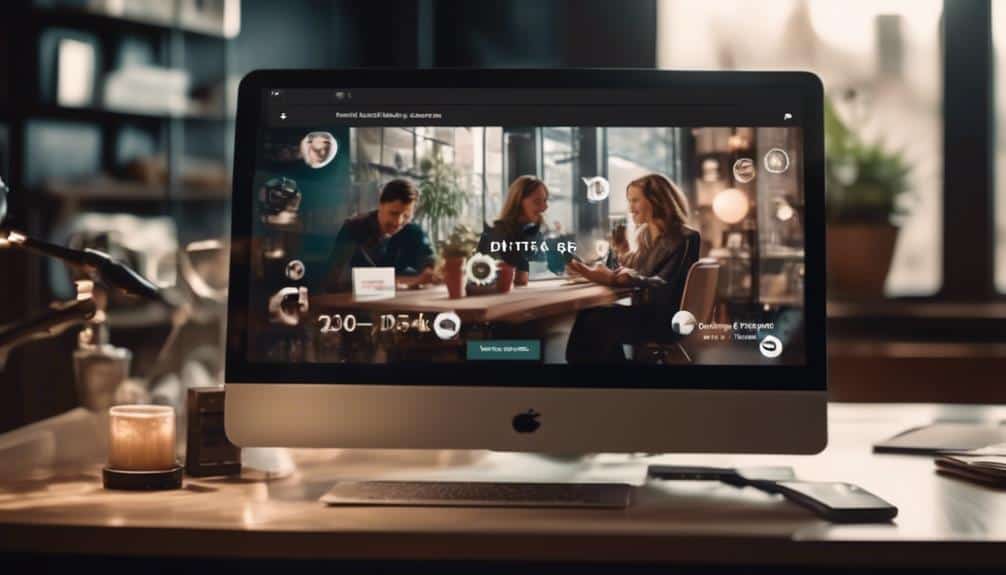Unlock the Future of Marketing With the Latest Email Automation Tools
They say 'time is money,' and in the world of marketing, this couldn't be more true. As a business owner or marketer, you understand the importance of reaching your target audience in a timely and efficient manner. That's where email automation tools come in.
With the latest advancements in technology, these tools have revolutionized the way marketers communicate with their audience. But how exactly can they unlock the future of marketing?
In this discussion, we will explore the benefits of email automation, how to choose the right tool, and provide you with tips and best practices to ensure your success.
So, get ready to harness the power of automation and take your marketing efforts to new heights.
Key Takeaways
- Email automation and segmentation can streamline marketing efforts and increase productivity.
- The right email automation tool should be chosen based on needs and features, including customization, segmentation, A/B testing, and analytics.
- Setting up an effective email automation workflow involves focusing on essentials, tracking campaigns for insights, understanding the audience better, and utilizing segmentation strategies.
- Personalization tactics, such as implementing effective techniques, segmenting customers, tailoring content, and analyzing data, can take marketing efforts to the next level.
The Benefits of Email Automation

Are you looking for a way to streamline your email marketing efforts and increase your productivity? Email automation can provide a solution that saves you time, maximizes efficiency, and delivers better results.
By implementing email automation tools, you can experience increased efficiency and improved customer targeting.
One of the key benefits of email automation is increased efficiency. With automated emails, you can set up personalized campaigns that are triggered by specific actions or events. This means that you don't have to manually send emails to each individual on your list, saving you valuable time. Instead, you can focus on other important tasks while your automated emails work in the background, nurturing leads and engaging customers.
Additionally, email automation allows you to improve customer targeting. By segmenting your audience based on their preferences, behaviors, or demographics, you can send targeted emails that resonate with each group. This targeted approach increases the chances of your audience engaging with your emails and taking the desired action.
Choosing the Right Email Automation Tool
When choosing an email automation tool, it's important to carefully evaluate your needs and consider the features that will best support your marketing goals. With the abundance of email automation benefits available, finding the right platform can be overwhelming. To help you make an informed decision, consider the following factors:
| Features | Benefits |
|---|---|
| Customization | Personalize your emails for maximum impact |
| Segmentation | Target specific audiences for better results |
| A/B Testing | Optimize your campaigns for higher engagement |
| Analytics | Track and measure the success of your emails |
| Integration | Seamlessly connect with other marketing tools |
Setting Up Your Email Automation Workflow

Now that you have chosen the right email automation tool, it's time to set up your email automation workflow.
To ensure a successful campaign, you'll need to focus on three key points: workflow essentials, email segmentation strategies, and personalization tactics.
Workflow Essentials
To effectively set up your email automation workflow, it's essential to utilize the right tools and strategies. Workflow optimization is key to ensuring your email campaigns run smoothly and efficiently.
One important aspect of workflow optimization is email campaign tracking. By tracking your email campaigns, you can gain valuable insights into their performance and make data-driven decisions to improve your future campaigns. With the right tracking tools, you can monitor metrics such as open rates, click-through rates, and conversions. This information allows you to identify what works and what doesn't, enabling you to refine your email marketing strategy.
Additionally, tracking your campaigns helps you understand your audience better and tailor your messaging to their preferences.
Email Segmentation Strategies
Utilize effective email segmentation strategies to optimize your email automation workflow and deliver personalized content to your audience.
In today's rapidly evolving digital landscape, staying on top of email marketing trends is crucial for successful campaigns. Email segmentation is a powerful tool that allows you to divide your subscriber list into smaller, more targeted groups based on specific criteria such as demographics, preferences, or purchase history.
By segmenting your audience, you can create tailored messages that resonate with each group, increasing engagement and conversion rates. This level of personalization not only enhances the customer experience but also improves email campaign optimization.
With email segmentation, you can maximize the impact of your email automation workflow, ensuring that your messages reach the right people at the right time with the right content.
Personalization Tactics
Enhance your email automation workflow by implementing effective personalization tactics.
Personalization techniques can help you create more targeted and relevant email campaigns that resonate with your audience.
One key tactic is customer segmentation, which involves dividing your audience into specific groups based on their characteristics, behaviors, or preferences. By segmenting your customers, you can tailor your email content and offers to their specific needs and interests. This not only increases the chances of engagement and conversion but also helps build stronger relationships with your customers.
Remember to gather and analyze data to understand your customers better and create personalized experiences that make them feel valued and understood.
Incorporating personalization tactics into your email automation workflow can take your marketing efforts to the next level.
Personalizing Your Automated Emails

Make your automated emails more engaging and effective by personalizing them to your recipients' preferences and interests. Personalization benefits are numerous, including higher open and click-through rates, improved customer loyalty, and increased conversions.
To achieve effective personalization, start by segmenting your email list based on demographic information, purchase history, and user behavior. This allows you to tailor your content and offers to specific groups of recipients, increasing the relevance and value of your emails.
Additionally, use dynamic content to dynamically change the email content based on each recipient's preferences and actions. For example, you can include personalized product recommendations, personalized subject lines, or even personalized images to make your emails more compelling.
Furthermore, leverage automation tools that track and analyze customer interactions to send timely emails triggered by specific actions. For instance, you can send a personalized welcome email to new subscribers or a follow-up email to customers who abandoned their shopping carts.
Segmenting Your Email List for Better Targeting
When it comes to email marketing, personalization is key.
By segmenting your email list, you can deliver personalized content that speaks directly to the interests and needs of your subscribers.
This not only increases engagement rates but also improves the overall effectiveness of your email campaigns.
Personalized Email Content
To improve the effectiveness of your email marketing campaigns, consider segmenting your email list to deliver personalized content that resonates with your audience.
Personalized email design and email personalization techniques are powerful tools in engaging your subscribers and driving conversion rates. By tailoring your emails to specific segments of your audience, you can create a more personalized experience that speaks directly to their needs and interests.
This not only increases the chances of your emails being opened and read but also boosts the likelihood of recipients taking the desired action. Whether you segment based on demographics, behavior, or preferences, personalized email content allows you to connect with your audience on a deeper level, fostering trust and loyalty.
Increased Engagement Rates
To truly engage your subscribers and drive higher conversion rates, harness the power of segmenting your email list for better targeting. By dividing your audience into smaller, more specific groups, you can deliver personalized content that resonates with each individual. This approach not only increases open and click-through rates but also helps you build stronger relationships with your customers.
Here's how segmenting your email list can lead to increased engagement rates:
- Improved Relevance: Tailor your messaging to match the interests, preferences, and behaviors of each segment.
- Enhanced Personalization: Address subscribers by their names and provide content that speaks directly to their needs.
- Better Timing: Send emails at the right time based on the customer's journey, ensuring maximum impact.
- Increased Conversion Rates: By delivering targeted content, you can guide subscribers through the customer journey, optimizing their experience and increasing the likelihood of conversions.
Segmenting your email list is a powerful technique that can significantly improve your engagement rates and ultimately boost your conversion rates. Take the time to understand your subscribers and deliver content that truly speaks to their needs and interests.
Creating Effective Email Templates

Consider using email automation tools to create highly effective email templates.
The success of your email marketing campaigns relies heavily on the content and design of your emails. To capture your audience's attention, start with effective subject lines that grab their interest and entice them to open the email. Use action-oriented language and personalize the subject line whenever possible.
Once the email is opened, the design should be visually appealing and easy to navigate. Keep the layout simple and clean, with a clear call-to-action that directs readers to take the desired action. Use images sparingly but strategically, ensuring they enhance the message and don't distract from it.
Test your email templates across different devices and email clients to ensure they display correctly. Additionally, consider segmenting your email lists to deliver more targeted content and increase engagement rates.
Optimizing Your Email Delivery Rates
After creating effective email templates, the next step is to optimize your email delivery rates. Maximizing deliverability and improving open rates are crucial for the success of your email marketing campaigns.
Here are four strategies to help you achieve better email delivery rates:
- Clean your email list regularly: Remove inactive subscribers and addresses that bounce consistently. This ensures that you're sending emails to engaged and active recipients, increasing the chances of your emails being delivered and opened.
- Use a reputable email service provider: Choose an email service provider that has a strong reputation for delivering emails to the inbox rather than the spam folder. Look for features like authentication, spam score checking, and deliverability monitoring to ensure your emails reach their intended audience.
- Segment your email list: By segmenting your email list based on demographics, interests, or behavior, you can send targeted and relevant content to each group. This improves engagement and reduces the likelihood of your emails being marked as spam.
- Optimize your email subject lines and sender name: Craft compelling subject lines that pique curiosity and entice recipients to open your emails. Additionally, use a recognizable sender name that your subscribers trust and are familiar with.
Analyzing and Measuring Email Automation Success

Measuring the success of your email automation campaigns is vital for optimizing your strategy and achieving your marketing goals. To effectively measure the effectiveness of your email automation, you need to analyze key metrics and conduct a comprehensive email automation ROI analysis.
Start by tracking metrics like open rates, click-through rates, conversion rates, and unsubscribe rates. These metrics provide valuable insights into the engagement and effectiveness of your email campaigns. By monitoring these metrics, you can identify areas of improvement and make data-driven decisions to increase your email automation effectiveness.
Additionally, conducting an email automation ROI analysis is crucial to determine the return on investment of your campaigns. This analysis involves evaluating the revenue generated from your email automation efforts and comparing it to the costs involved in implementing and managing these campaigns. By calculating your email automation ROI, you can assess the profitability of your email marketing strategy and make informed decisions about resource allocation.
Integrating Email Automation With Other Marketing Tools
By integrating email automation with other marketing tools, you can achieve seamless tool integration and enhance your overall marketing capabilities. This integration allows you to streamline your marketing efforts, automate repetitive tasks, and improve the efficiency of your campaigns.
With a unified marketing system, you can track customer interactions, analyze data, and deliver personalized content, ultimately driving better results for your business.
Seamless Tool Integration
Integrate your email automation seamlessly with other marketing tools to streamline your campaigns and maximize efficiency. By integrating your email automation with other marketing tools, you can unlock a range of benefits that will take your marketing efforts to the next level.
Here are four reasons why seamless tool integration is crucial for your email automation strategy:
- Increased data accuracy: Integrating your email automation with other marketing tools ensures that your data remains consistent across all platforms, eliminating the need for manual data entry and reducing the risk of errors.
- Enhanced customer segmentation: By connecting your email automation with other tools, you can gather more comprehensive customer data, allowing you to target your audience more effectively and personalize your messages.
- Improved campaign tracking: Integration allows you to track and analyze the performance of your email campaigns in real-time, providing valuable insights to optimize your marketing strategy.
- Time and cost savings: Automating the integration process saves you time and resources, enabling you to focus on other aspects of your marketing efforts.
Enhanced Marketing Capabilities
Enhance your marketing capabilities by seamlessly integrating email automation with other powerful marketing tools. By combining the functionality of email automation with other tools, you can create enhanced targeting strategies and implement automated lead nurturing campaigns.
Integrating email automation with tools such as customer relationship management (CRM) systems allows you to gather valuable data about your customers and their preferences. This data can then be used to personalize your email campaigns and target specific segments of your audience with relevant content.
Furthermore, integrating email automation with social media management tools enables you to reach your audience across multiple channels and engage with them more effectively. You can sync your email campaigns with social media posts, ensuring consistent messaging and maximizing your reach.
Tips and Best Practices for Email Automation Success

To maximize the effectiveness of your email automation campaigns, it's crucial to implement key tips and best practices. Here are four essential strategies that will help you achieve email automation success:
- Segment your audience: Tailor your messages to specific groups based on their demographics, behavior, or preferences. By sending targeted emails, you can increase engagement and conversion rates.
- Personalize your content: Use dynamic content and merge tags to include personalized information in your emails. Addressing your recipients by name and providing relevant recommendations can foster a stronger connection and drive better results.
- Test and optimize: Continuously test different elements of your email campaigns, such as subject lines, call-to-action buttons, and layouts. Analyze the results and make data-driven decisions to optimize your emails for better performance.
- Maintain a clean email list: Regularly clean your email list by removing inactive subscribers and updating contact information. This will improve deliverability rates, reduce bounce rates, and ensure that your messages reach the right audience.
Frequently Asked Questions
What Are Some Common Challenges Faced When Implementing Email Automation?
Implementing email automation can pose challenges, but with best practices, you can overcome them. Streamlining workflows, personalizing content, and maintaining deliverability are key. Unlock the future of marketing by embracing these tools.
How Can Email Automation Help Improve Customer Engagement and Retention?
Improve customer engagement and retention with email automation. Personalization strategies can tailor content to individual preferences, increasing customer satisfaction. Conversion rate optimization can drive more sales by delivering targeted messages and offers. Start unlocking the future of marketing today!
Are There Any Limitations or Drawbacks to Using Email Automation?
There are limitations and drawbacks to using email automation. It may lead to impersonal communication and spamming. Additionally, technical issues and the need for constant monitoring can be challenging. However, these can be overcome with proper planning and strategy.
What Are Some Important Factors to Consider When Selecting an Email Automation Tool?
When selecting an email automation tool, consider integration options and cost. Ensure the tool integrates seamlessly with your existing systems and meets your budget. This will help you streamline your marketing efforts and maximize your return on investment.
Can You Provide Examples or Case Studies of Successful Email Automation Campaigns?
You'll be amazed at the success of email automation campaigns. With the latest tools, you can reach your target audience at the right time, increase engagement, and boost conversions. The benefits of email automation in marketing are endless!
Conclusion
Unlock the future of marketing with the latest email automation tools. By implementing email automation, you can benefit from increased efficiency, improved targeting, and personalized customer experiences.
Choose the right email automation tool to streamline your workflows and optimize your email delivery rates. Don't forget to segment your email list for better targeting and analyze the success of your email automation campaigns.
Integrate email automation with other marketing tools for a cohesive and effective strategy. Follow these tips and best practices to achieve email automation success and stay ahead in the competitive marketing landscape.








